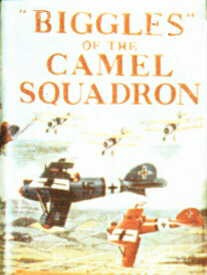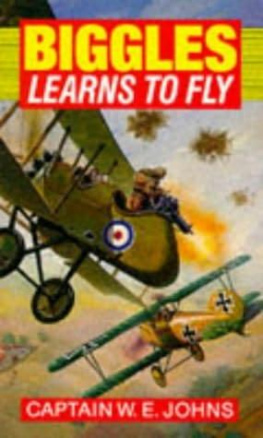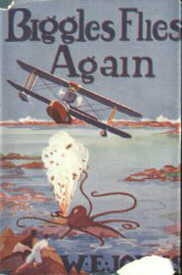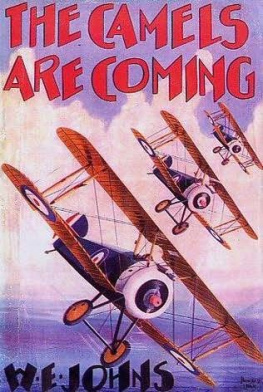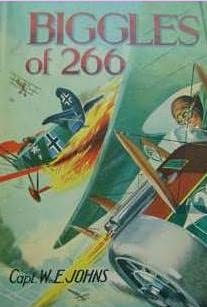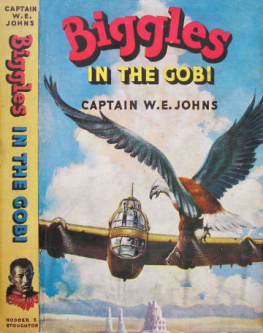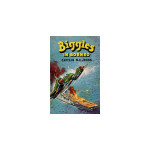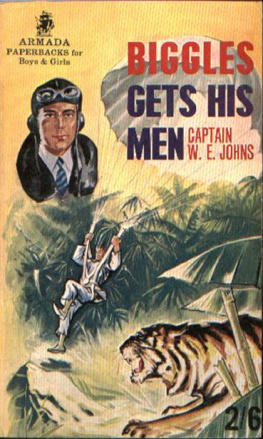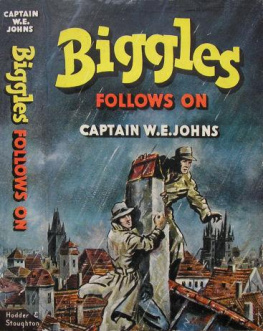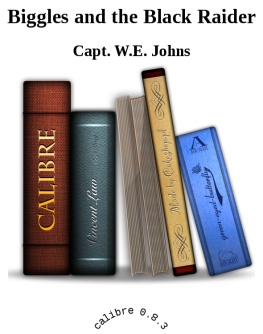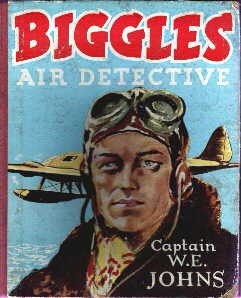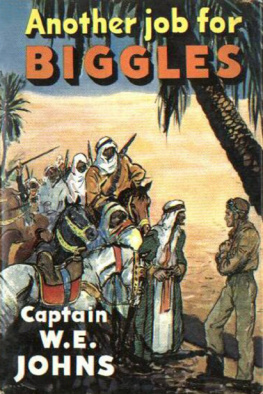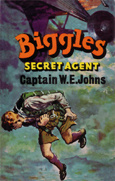W. E. Johns - Biggles of the Camel Squadron
Here you can read online W. E. Johns - Biggles of the Camel Squadron full text of the book (entire story) in english for free. Download pdf and epub, get meaning, cover and reviews about this ebook. year: 1960, publisher: Dean & Son Ltd, genre: Detective and thriller. Description of the work, (preface) as well as reviews are available. Best literature library LitArk.com created for fans of good reading and offers a wide selection of genres:
Romance novel
Science fiction
Adventure
Detective
Science
History
Home and family
Prose
Art
Politics
Computer
Non-fiction
Religion
Business
Children
Humor
Choose a favorite category and find really read worthwhile books. Enjoy immersion in the world of imagination, feel the emotions of the characters or learn something new for yourself, make an fascinating discovery.
- Book:Biggles of the Camel Squadron
- Author:
- Publisher:Dean & Son Ltd
- Genre:
- Year:1960
- Rating:4 / 5
- Favourites:Add to favourites
- Your mark:
- 80
- 1
- 2
- 3
- 4
- 5
Biggles of the Camel Squadron: summary, description and annotation
We offer to read an annotation, description, summary or preface (depends on what the author of the book "Biggles of the Camel Squadron" wrote himself). If you haven't found the necessary information about the book — write in the comments, we will try to find it.
Biggles of the Camel Squadron — read online for free the complete book (whole text) full work
Below is the text of the book, divided by pages. System saving the place of the last page read, allows you to conveniently read the book "Biggles of the Camel Squadron" online for free, without having to search again every time where you left off. Put a bookmark, and you can go to the page where you finished reading at any time.
Font size:
Interval:
Bookmark:
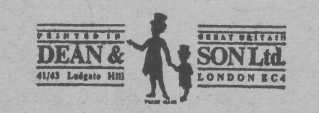
OF THE
By CAPT. W. E. JOHNS
By arrangement with THE THAMES PUBLISHING CO.
MADE AND PRINTED IN GREAT BRITAIN BY PURNELL AND SONS, LTD.
PAULTON (SOMERSET) AND LONDON
SCAN : AK3D
Proofed by (1) an unknown drunk whod be loved forever and (b) an anonymous mystery FOREWORD by Capt. W. E. Johns
Biggles was not entirely a fictitious character. True, he did not exist, as far as I am aware, under that name, but the exploits with which he has been credited have nearly all been built on a foundation of truth, although, needless to say, they were not all the efforts of a single individual. Students of air-war history may recognise some of the incidents, and the names of the officers associated with them, although they are now presented in fiction form.
Sceptics may doubt this. Let them. The old saying about truth being stranger than fiction was never more apposite than in war flying, and I have hesitated to record some of the events which came under my personal notice for that very reason. I would not dare to "arrange" a collision between an aeroplane and a kite balloon, and allow the hero to survive. Yet Willy Coppens, the Belgian ace, did just that, and is alive today to tell us about it.
Again, what author would dare to make his hero slide down the cable of a captive kite balloon to the ground, without being killed? Yet it happened, and I have heard the story from the officer's own lips, and seen his hands, which still bear the marks of that grim adventure. A photograph is still extant of the machine that rammed an eight-hundred-foot wireless pylon. The pilot was knocked unconscious in the crash, and the machine remained transfixed in the pylon, hundreds of feet above the ground. Of all the amazing aeroplane crashes that surely holds the palm. It is almost incredible that the pilot survived, but he did.
I merely mention these facts to demonstrate to those unfamiliar with war flying history what amazing things could, and did, happen, things far more strange than those recorded in this book, which-and I say this in order that there should be no misunderstanding-has been written more for the entertainment of the younger generation than the hard-baked warrior. Technical expressions have therefore been avoided as far as possible, and the stories told in a form which I hope everyone will be able to understand. In case of doubt, there is a short glossary in the book for those to whom early war flying reading matter is new.
Finally I hope that something may be learned from the "combat tactics" employed by Biggles and his friends by those who may one day find themselves in the cockpit of a fighting aeroplane, carrying on the glorious traditions of the flying service.
Postscript
The hope expressed when the last paragraph above was written was realised ten years later, when the first readers of these stories, fighting in World War II, wrote to me to say that they owed much to Biggles. In 1944 one of our leading fighter pilots, asked by a reporter from a Sunday newspaper to what he owed his success, answered "Biggles". The reporter naively headed his article "Who is Biggles?" I gather a lot of people answered his question.
HOW BIGGLES WAS "BORN"
These stories of World War I were written about a character whose exploits-little suspected by me at the time-were to continue to the present day. The first stories were written for a magazine of which I was the editor, and apart from the entertainment of the reader had the more serious purpose of presenting a picture of war flying as it was in its infancy. It seems unlikely that anyone could have suspected the developments that were to follow and astonish us in World War II. In 1914 war flying began with pilots trying to drop stones on each other. The pistol followed, then the carbine, and the first casualties occurred. The next step was an ordinary ground machine-gun. Later, this was fixed to the machine. A great stride was made when a timing gear was produced to allow first one, then two, machine-guns to fire forward through the airscrew-at that time incorrectly called a propeller. Even in 1918 armament was still primitive compared with the types that fought in the Battle of Britain. Air combat was mostly a matter of "catch as catch can", with every man for himself. Tricks and ruses were common. Discipline was casual, for the senior officers of the R.F.C. had not had time to grow old.
In short, it was the era of experiment, of trial and error.
But it was from the apparently irresponsible behaviour of the pilots of the Kaiser's war that the traditions of the air service emerged. Discipline, speed and striking power may have been stepped up, but the human factor is the same.
W.E.J.
Altimeter: The instrument used for determining the height of an aeroplane. It is not unlike a barometer, and is set in the instrument board.
Ammonal: A very powerful explosive. It was used in Mills bombs. Archie: The old Royal Flying Corps expression for antiaircraft gun-fire. In World War II it became
"flak".
"Blipping": The art of opening the throttle of a rotary engine in short, sharp bursts to keep it "alive". Bomb-Toggle: The bomb release handle.
Bowden Lever: The machine-guns of certain aeroplanes were fired by depressing a lever on the joystick. Sometimes a thumb button was used in the top of the joystick. Other methods were also employed according to the type of machine.
Brass-Hats: A common expression meaning staff officers, no doubt originating from the gold device on the peaks of their caps-often referred to as "bananas". Bristol Fighter: A famous type of two-seater British all-purpose aeroplane. Buckingham: A type of incendiary bullet, calculated to set fire to anything it hit. They were used chiefly against lighter-than-air craft in order to set fire to the hydrogen gas with which these were inflated.
Camouflage: A word coined from the French, meaning "to conceal", "disguise", or make a thing look like something it was not. Many different forms of camouflage were employed during the war. Imitation grass mats, spread above guns, was known as camouflage. The painting of buildings, hangars and guns in sections of different colours, in order to break up their outlines, was also known as camouflage.
Centre Section: That part of the top plane of an aeroplane which comes immediately over the fuselage, and to which the wings themselves are joined.
Circus: Formations of enemy aeroplanes were commonly called circuses often they were known by the name of the leader: thus "Richthofen's circus".
Cooper Bombs: Special bombs generally reckoned to weigh twenty pounds, although as a matter of fact they usually weighed about twenty-five pounds, often carried by single-seat fighters under the wings, four each side.
Deflection: The allowance made when shooting at a moving target. Briefly, it means shooting at the place where the target is expected to be when the missile reaches it. Double-Frontiers: In order to prevent prisoners of war from escaping, the Germans, in many places, arranged artificial or false frontiers in order to lead escaping officers to believe that they had entered another country, whereas in fact they had not.
Fanning (Down): An R.F.C. expression for blowing up with bombs. Things were fanned down, not blown up.
Flaming Onions: Missiles used by the Germans against aeroplanes in World War I. The weapons that fired them remained a mystery until the end of the war. They appeared in a series of glowing balls of fire that rose vertically from the ground.
Next pageFont size:
Interval:
Bookmark:
Similar books «Biggles of the Camel Squadron»
Look at similar books to Biggles of the Camel Squadron. We have selected literature similar in name and meaning in the hope of providing readers with more options to find new, interesting, not yet read works.
Discussion, reviews of the book Biggles of the Camel Squadron and just readers' own opinions. Leave your comments, write what you think about the work, its meaning or the main characters. Specify what exactly you liked and what you didn't like, and why you think so.

